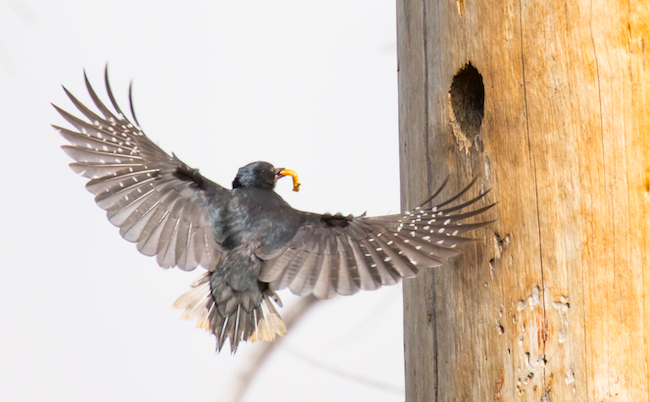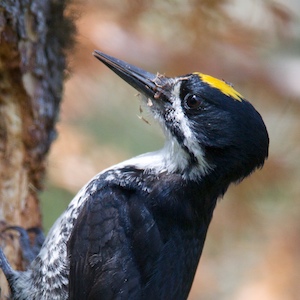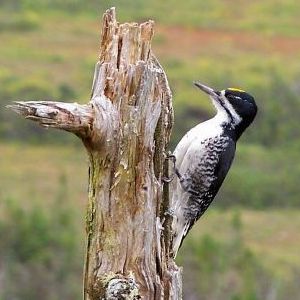Back in 2014 and 2015, IBP’s Black-backed Woodpecker survey crews working in the Moonlight Fire spent some extra time observing nests through a scope to record data on parental behavior. They recorded how often parents delivered food to their nestlings, the size of the food delivered, and which parent made the delivery. This work was part of IBP’s larger project, conducted in partnership with the US Forest Service, studying how changing wildfires and forest management practices affect this post-fire specialist.
But while the Black-backed Woodpecker project has produced over a dozen research papers by IBP authors and associates since 2015, the parental provisioning dataset didn’t find a home in any of these publications. It was summarized for the Forest Service and then left unused until 2019 when John Loverin, an undergraduate at the University of Connecticut, went looking for an honors thesis.
Loverin was working in the lab of IBP research associate Dr. Morgan Tingley (who has since moved to UCLA) and was mentored by Andrew Stillman (now a fully-fledged Ph.D.) who studied Black-backed Woodpeckers in partnership with IBP. He was interested in the intersection of animal behavior and statistics, but he needed some data to get started on a study of his own. Stillman put his head together with Bob Wilkerson, the IBP staff biologist and Black-backed Woodpecker guru who manages the larger woodpecker project. They remembered the orphaned parental provisioning dataset and an honors thesis was born.
Earlier this month, that thesis was published as a research paper in the Journal of Field Ornithology. Loverin and co-authors from the Tingley lab, the US Forest Service and IBP examined the relationship between parental provisioning behavior and the habitat characteristics of fires and post-fire management. In addition, they looked at how provisioning differs between male and female parents and how it varies across the breeding season.
They found that parental provisioning behavior did not differ between the sexes and that variation in this behavior is better explained by temporal variables – such as nestling age and nest initiation date – rather than habitat variables such as burn severity and distance to unburned or low severity burned areas.
We talked to John Loverin and his co-author and mentor Andrew Stillman about this work.
Did any of your results surprise you?
John: I was surprised that the habitat variables related to fire did not affect provisioning rate or prey size. I thought these would be important because Black-backed Woodpeckers in the western United States are strongly associated with post-fire habitats, however it seems that this did not matter because all the nests were in high-severity burn, and there was not enough habitat variation to see the effects of different burn severities.
Another surprising result was that as the amount of post-fire logging increased, so did the probability of delivering a large grub. Since post-fire logging removes snags that woodpeckers rely on to find food, we expected a relationship in the opposite direction. We thought this may have been due to woodpeckers selecting larger grubs to compensate for a longer distance traveled to get food.
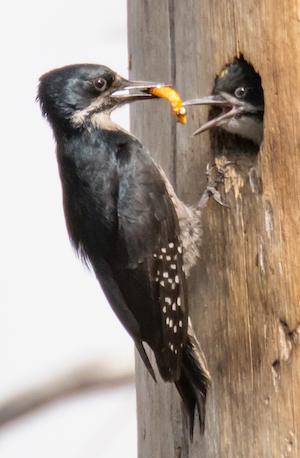
A female Black-backed Woodpecker delivers a beetle larva to her nestling. Photo by Jean Hall.
You mentioned that the lack of effect of habitat on provisioning may be due to lack of variation in habitat within this particular dataset and because Black-backed Woodpeckers are so selective. Based on Andrew's other data and experience in the field do you think that there likely would be an effect of habitat (burn severity and/or post-fire logging) if you had an expanded dataset (i.e. multiple fires or areas with more logging)? Or do you think that the woodpeckers are so selective about where they nest, they are only going to pick places where they can provision sufficiently?
Andrew: We were initially surprised to see that temporal variables, like days since hatching, better explained provisioning rates than characteristics of the burned habitat. However, a closer look revealed that there was precedent for this finding in the literature and previous studies conducted by IBP (for instance our 2019 paper on nest site selection). What we learned was that this finding likely points to the idea that the birds we observed had all arrived at a good place to nest and find their favorite food in the charred forests of the Moonlight fire – especially compared to the nearby unburned forests where dead trees are scarce. Elsewhere in California, Black-backed Woodpeckers have been found nesting in unburned forests, such as areas with large numbers of trees killed by bark beetles. If nests from unburned areas were included in a similar analysis, I would expect to find a strong effect of habitat – especially burn severity or snag density – on provisioning rates.
John, you are now at Texas A&M University-Kingsville pursuing a master’s degree. Congratulations! What will you be studying?
John: For my master’s degree, I am studying how forest management affects resilience to disturbances such as wildfires, insects, and drought, and how these forests and these relationships will change in the future due to climate change. I am also researching what the optimal density is in forests affected by drought and climate change, and how to achieve that density through management actions such as thinning and prescribed burning. Coincidentally, the dataset I will be working with is from same area in northern California where the Black-backed Woodpecker data was collected!
Working on the Black-backed Woodpecker paper and other things in the Tingley lab helped get me more interested in statistics, which is something I plan to pursue in my career after I get my master’s degree. Working on this research also gave me exposure to programming in R, which I use a lot during my current research for my master’s project.
Anything you’d like to add Andrew?
Andrew: The more we work with Black-backed Woodpeckers, the more surprises we find. Spending hours watching behavioral observations at nests gives you a lot of appreciation for the behavioral differences between individual birds, and we enjoyed seeing evidence for this in the fieldnotes from IBP’s nest observers. Just like human parents, some Black-backed Woodpeckers seemed relaxed and unconcerned, while other birds seemed especially tight or wary. Others showed signs of agitation if observers came into view. In order to record unbiased provisioning data, observers would sometimes have to slowly sneak into the forest stand and crouch 60 meters away from nests while recording data through a birding scope! We are grateful for the hard work and dedication of the IBP field technicians who located Black-backed Woodpecker nests and collected the data used in this study. This project also would not have been possible without support from Plumas National Forest.
Back in the lab, John was an extremely capable and quick learner as he peeled back the layers of IBP’s provisioning dataset. This project highlights his ability to overcome challenges and demonstrates his dedication to seeing an idea through from start to finish. His colleagues in the Tingley lab and IBP wish him the best in his graduate program and future career!
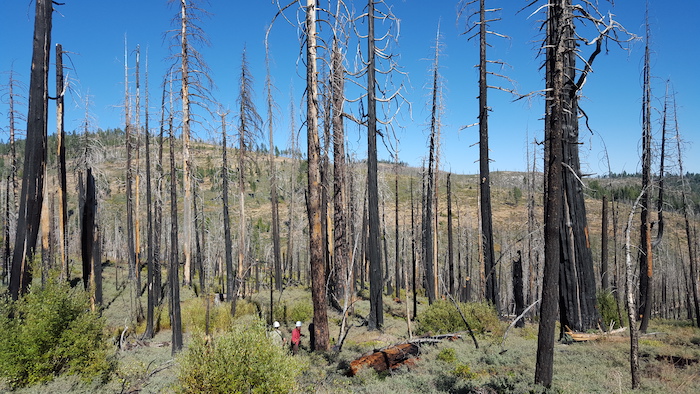
An IBP crew working in the Moonlight fire in 2015.


